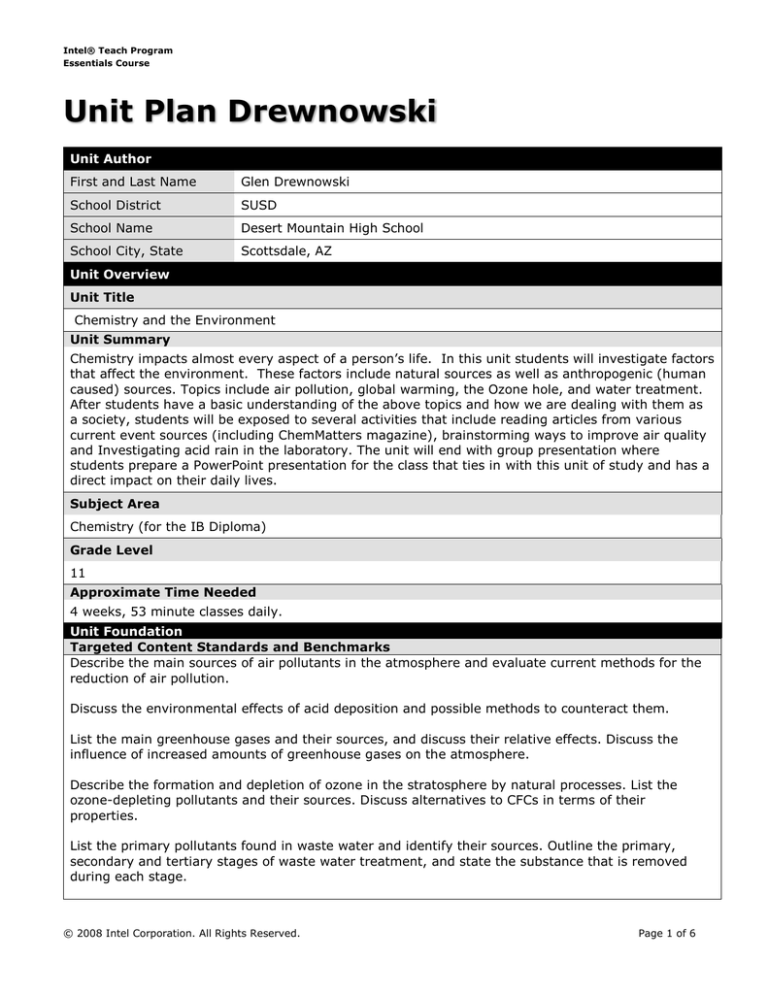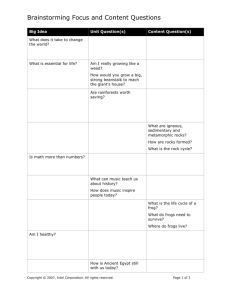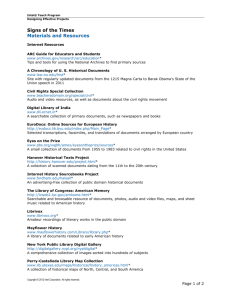
Intel® Teach Program
Essentials Course
Unit Plan Drewnowski
Unit Author
First and Last Name
Glen Drewnowski
School District
SUSD
School Name
Desert Mountain High School
School City, State
Scottsdale, AZ
Unit Overview
Unit Title
Chemistry and the Environment
Unit Summary
Chemistry impacts almost every aspect of a person’s life. In this unit students will investigate factors
that affect the environment. These factors include natural sources as well as anthropogenic (human
caused) sources. Topics include air pollution, global warming, the Ozone hole, and water treatment.
After students have a basic understanding of the above topics and how we are dealing with them as
a society, students will be exposed to several activities that include reading articles from various
current event sources (including ChemMatters magazine), brainstorming ways to improve air quality
and Investigating acid rain in the laboratory. The unit will end with group presentation where
students prepare a PowerPoint presentation for the class that ties in with this unit of study and has a
direct impact on their daily lives.
Subject Area
Chemistry (for the IB Diploma)
Grade Level
11
Approximate Time Needed
4 weeks, 53 minute classes daily.
Unit Foundation
Targeted Content Standards and Benchmarks
Describe the main sources of air pollutants in the atmosphere and evaluate current methods for the
reduction of air pollution.
Discuss the environmental effects of acid deposition and possible methods to counteract them.
List the main greenhouse gases and their sources, and discuss their relative effects. Discuss the
influence of increased amounts of greenhouse gases on the atmosphere.
Describe the formation and depletion of ozone in the stratosphere by natural processes. List the
ozone-depleting pollutants and their sources. Discuss alternatives to CFCs in terms of their
properties.
List the primary pollutants found in waste water and identify their sources. Outline the primary,
secondary and tertiary stages of waste water treatment, and state the substance that is removed
during each stage.
© 2008 Intel Corporation. All Rights Reserved.
Page 1 of 6
Intel® Teach Program
Essentials Course
Outline and compare the various methods for waste disposal. Describe the recycling of metal, glass,
plastic and paper products, and outline its benefits.
Student Objectives/Learning Outcomes
Students will be able to:
Describe the sources and effects of pollutants in the atmosphere.
Discuss ways to reduce pollutants and to curb the occurance of acid deposition.
Evaluate ways to reduce greenhouse gases in the atmosphere to reduce the effect of global warming.
Use equations to show how stratospheric ozone is formed and broken down (naturally and through
anthropogenic means).
Diagram the waste water treatment process.
Compare and contrast means of dealing with waste including recycling, landfills and incineration.
Curriculum-Framing Questions
Essential
Question
How does Chemistry impact my life?
How are people impacting the environment?
What can we do to stop the growth of the Ozone hole?
Unit
Questions
How can we improve air quality?
Are people causing global warming?
What can people do to reduce the impact of global warming?
How can people reduce the amount of waste that must be processed?
What are the main sources of carbon monoxide (CO), oxides of nitrogen
(NOx), oxides of sulfur (SOx), particulates and volatile organic compounds
(VOCs) in the atmosphere?
What pollutants make up acid rain and which acids are formed?
Content
Questions
Carbon dioxide is a greenhouse gas in our atmosphere. This gas has a very low
heat absorption quality when compared to Nitrous oxide or methane. Why is it
considered to be such a problem?
Show the natural formation and destruction of stratospheric ozone using
equations.
How do CFCs and Nitrogen oxides destroy ozone in the stratosphere? Use
equations to answer.
Outline the process used to prepare water to be ready for drinking. What is
removed at each step?
© 2008 Intel Corporation. All Rights Reserved.
Page 2 of 6
Intel® Teach Program
Essentials Course
Assessment Plan
Assessment Timeline
Before project work begins
K-W-L chart
Class
Discussion
Teacher
presents
necessary
background
information
Students work on projects
and complete tasks
Student
Feedback
Form
Students take
notes
Assign project
topic
Background
Student Inquiry
Form
K-W-L chart
quiz
Go over
project criteria
and rubric
Group
After project work is
completed
Project
presentation
rubric
Questioning
members work Blog
together to
plan their
PowerPoint
and
presentation
K-W-L chart
Student self
evaluation/
reflection
Unit Test
Student
Feedback Form
Assessment Summary
Before new information is given and the project is introduced students will fill out the first two
columns of the K-W-L. This will let me know what students already know about environmental issues
and what they want to know. They will turn this in so I can gauge students’ knowledge and
understanding then they will get this back so they can fill in the 3 rd column as the progress through
the project process.
I will give background information to the topic and assign the project to the groups. This will be
using my prepared PowerPoint lectures and discussion.
Each group will have a particular portion of the unit to research and present to the class. When I
assign the project, I will form the groups of students, go over the rubric and go over the information
that must be included in their presentation. I will also give some suggestions of where to get
information. Discuss the blogs that will be posted during the presentation time period. It is
mandatory that all students participate by responding to at least two different blog questions and
making comments on a fellow student’s entry. I will go over the blog etiquette and will discuss the
rubric with the students.
Students will then fill out the Student Inquiry form so that they can ask themselves what they want
to know about their topic and how that will fit into what they need to include in their presentation.
They will have freedom to explore, but there will be specific items that must be included in their
project presentation.
As the project time progresses (some of the project will be completed at home while other parts will
be compiled in class), students will take notes on information I present in class and they will be
quizzed on necessary background information.
Every 3 days (generally on Monday and Thursday) students will fill out and turn in the Student
Feedback Sheet. This gives them a chance to let me know where they are in the research process,
any frustrations they encounter and how they will deal with these frustrations.
© 2008 Intel Corporation. All Rights Reserved.
Page 3 of 6
Intel® Teach Program
Essentials Course
As the presentations begin, a blog will be posted for students to answer that will cover real-world
questions from each topic. Students will enter their comments and respond to someone’s comment
over the course of the presentation period. After each presentation questioning will be used to
assess student understanding, not just from the presenters, but for the rest of the class as well.
Students will turn in the K-W-L and their blog rubric, and do a self-evaluation after their presentation
is complete.
Unit Details
Prerequisite Skills
Students should be able to write balanced chemical equations.
Instructional Procedures
The unit will open with the K-W-L to gauge students’ prior knowledge. Students will fill out the first
two columns answering what they know about environmental issues and what more they would like
to know.
From there, class discussions and teacher lecture using PowerPoint presentations will give the
student necessary background information to prepare them for the unit. Focus will be on writing the
correct chemical equations to demonstrate the chemical reactions occurring with air pollution, acid
rain, ozone depletion and greenhouse effect. Throughout this project process, information will be
imparted by the instructor and a quiz on this background information will be administered prior to
the presentations.
Groups will be formed so that there is a mixture of student levels in each group. The project will be
discussed and reviewed thoroughly so that all students will know their topic and what their task is as
part of the group. The stronger student is usually given the job of the group leader and all students
will have to decide on how to break up the work and distribute it evenly amongst the group
members. I will discuss the requirements of the project by using a PowerPoint.
The project will be done partially at home individually and partially in class as the information is
brought to the group and combined into the PowerPoint presentation. Students will fill out the
Student Feedback form twice a week so I can make sure students are on track and moving in the
right direction for their topic.
At the end of the unit, students will turn in their PowerPoint presentations to me along with their
rubrics. The students listening to the presentations must take notes so that they will be familiar with
the information that will be presented on a test at the end of the unit.
As presentations begin, I will post a blog on the related presentation topic. Students may begin
answering the blog questions. Students will turn in their project rubric right before their presentation
begins, and will complete a self-evaluation form to be turned in two days after they present. They
will evaluate their role in the project process and in the presentation.
At the end of all the project presentations, all students will turn in:
The final K-W-L the third column stating what they have learned throughout the unit completed;
The blog rubric so I can evaluate their blog responses.
© 2008 Intel Corporation. All Rights Reserved.
Page 4 of 6
Intel® Teach Program
Essentials Course
Accommodations for Differentiated Instruction
Special Needs
Students
Nonnative
Speakers
Gifted/Talented
Students
The teacher will organize the groups so that a strong student will be
paired with a special needs student. This will give additional support for
that student to learn from their classmate. The teacher will also be more
available for special needs student(s). More time will be allotted for
these students to turn in their work. That group will be able to present
last so that there is enough time to accommodate the special needs
student. I would also provide more direction for web searches so that
the student can more easily find proper sources for their project. If that
student needs the project broken down and chunked into smaller pieces,
I would have that ready for the student(s). If speaking is an issue for
the student, their oral part in the presentation can be smaller than that
of the rest of the group members.
For non-native speakers, a list of vocabulary words can be provided in advance
to that student. Since Arizona is an English only state for language in schools,
teachers and students must use English during the teaching process. Again, a
stronger student would be part of this group to help the non-native speaker.
There can be a component related to that native language incorporated into the
project such as a way their country may be handling the problem of Global
Warming or what types of air pollution affect their country.
The gifted students will be my stronger students. They would be split up to
become the group leaders and they will add assistance to special needs or nonnative speaking students. If they finish their part of the work early, they can
begin designing the PowerPoint to be ready for inclusion of all the student
components. They would also be able to meet with other group leaders to
discuss creative ways to design the PowerPoint as slong as the other leaders
were also finished with their research.
Materials and Resources Required For Unit
Technology – Hardware (Click boxes of all equipment needed)
Camera
Laser Disk
VCR
Computer(s)
Printer
Video Camera
Digital Camera
Projection System
Video Conferencing Equip.
DVD Player
Scanner
Other
Internet Connection
Television
Technology – Software (Click boxes of all software needed.)
Database/Spreadsheet
Image Processing
Web Page Development
Desktop Publishing
Internet Web Browser
Word Processing
E-mail Software
Multimedia
Other PowerPoint
Encyclopedia on CD-ROM
© 2008 Intel Corporation. All Rights Reserved.
Page 5 of 6
Intel® Teach Program
Essentials Course
Printed Materials
Chemistry, Zumdahl/Zumdahl. Houghton Mifflin Co, 2003;
Chemistry for the IB Dipolma, Neuss, Oxford
Acid Rain Lab Instructions (Drewnowski)
K-W-L Environmental Issues
Student Feedback Form
Student Inquiry Rubric
Presentation Rubric
Background Quiz
Unit Test
Sign up for lab time
Supplies
My Environmental PowerPoint for background information.
Make copies of all student handouts
Internet Resources
Other Resources
http://ozonewatch.gsfc.nasa.gov
Students will find these as they research
Guest Speaker: Mr. Ronald Drewnowski, Engineer and environmental expert
and former employee of New Jersey Public Service Electric & Gas (PSE&G)
Programs of the Intel® Education Initiative are funded by the Intel Foundation and Intel Corporation.
Copyright © 2007, Intel Corporation. All rights reserved. Intel, the Intel logo, Intel Education Initiative, and Intel Teach Program are
trademarks of Intel Corporation in the U.S. and other countries. *Other names and brands may be claimed as the property of others.
© 2000-2007 Intel Corporation. All Rights Reserved.
Page 6 of 6




